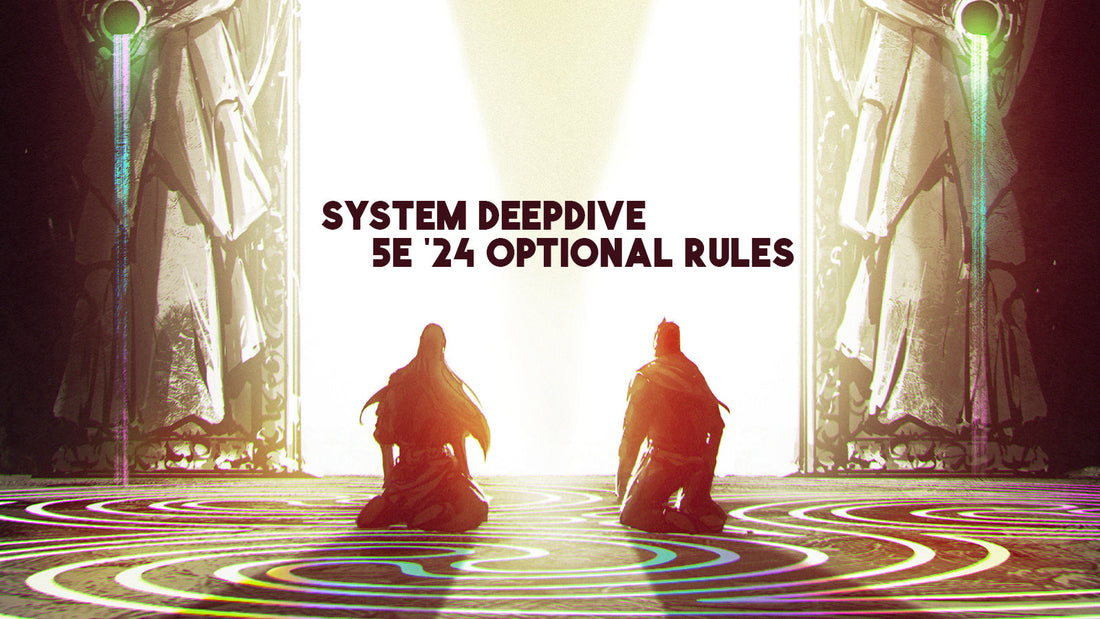
System Deepdive: 5e '24 Optional Rules
Share
The release of the 2024 5E marks a major milestone for the game. This update builds on the foundation established by the 2014 edition, and while it keeps the core mechanics intact, a considerable amount of minor details have changed. This analysis explores the most significant changes in the 2024 rules, comparing them with the 2014 edition and breaking down how these updates affect gameplay, character creation, and the overall roleplaying experience.
Terminology
One of the most noticeable changes in the 2024 update is the replacement of the term “race” with species when referring to playable characters like elves, dwarves, or humans. This shift reflects modern cultural sensitivity and removes certain implications of biological determinism from the game. The change acknowledges that a character’s identity and capabilities are determined by their backgrounds rather than their biological/racial traits. As an extension of this change, character creation changes accordingly.
Character Creation: Species and Backgrounds
In the 2014 edition, ability score increases were tied to a character’s race, which reinforced certain stereotypes about which races were better suited for specific roles. For example, elves naturally had a bonus to Dexterity, making them ideal for stealth-based classes like rogues and rangers, whereas half-orcs were best suited to become barbarians or fighters. The 2024 revision separates ability scores from species, linking them instead to a character’s background.
This update allows for more flexible character creation and eliminates the need to select specific species to optimize certain builds. It encourages personalized character development without sacrificing mechanical balance.
Another big change involves how mixed ancestries like half-elves and half-orcs are handled. The 2024 rules no longer treat them as separate species. Instead, players can mix and match traits from one parent species while describing their character’s appearance and backstory as a blend of both. This approach stretches the rules further and gives players more narrative freedom.
Class Structures
The 2014 edition introduced 12 core classes, some of which gained access to their archetypes at 1st level, while others had to wait until 2nd or even 3rd level. The 2024 update standardizes archetype progression; now, all classes choose their archetypes at 3rd level.
This standardization makes the learning curve more manageable for new players and ensures that players have time to understand their core class mechanics before diving into subclass choices. However, this choice changes the narrative of the classes. Clerics used to gain their domains at 1st level, which meant you knew right away which god or divine force you served; it was built into the class mechanics. Now, you can shape your character’s narrative from the start, but you won’t choose a domain until 3rd level. This can create a bit of a narrative gap since divine beings grant you your spellcasting ability, yet mechanically, you don’t establish which deity or concept gives you your powers until later.
Feats
Feats were considered an optional mechanic in the 2014 edition, with certain classes like fighter gaining them more often than others. The 2024 rules integrate feats into character progression more directly. Players now select a feat as part of their background and gain additional feats at certain levels. Now, backgrounds are really the backbone of your character and the single defining mechanic of your identity.
Fighting styles are now feats. If your class requires a fighting style, you now have access to all of them. This allows a wide range of classes to adopt different combat techniques and provides more strategic flexibility in building characters, which makes sense with the general spirit of the update.
Weapon Mastery
A major new addition, and an interesting one, to the 2024 rules is the addition of Weapon Mastery, which grants certain classes advanced abilities with specific weapons. For example, a longsword with Weapon Mastery might allow a character to disarm an opponent or inflict extra damage under certain conditions. This encourages players to think more strategically about their weapon choices and how they engage in combat, while nurturing the feeling that weapons matter beyond their damage dice.
Actions
The new update gives actions a serious glow-up. The new Magic action finally makes spellcasting feel like it belongs in the action economy instead of being like that weird cousin who sometimes shows up at family gatherings. Grappling and shoving now fall under Unarmed Strikes with set DCs, replacing the old, clunky contested rolls. No more of those “Wait, how does this work again?” moments. That being said, contested rolls made sense narratively as grappling and shoving are struggles between two actors rather than a simple “could I hit it” situation.
The addition of the Study and Influence actions brings structure to social and investigative play, making charisma-based characters feel more mechanically relevant outside of persuasion rolls. Yeah, you could still study your target, ask questions to your GM about it, but now you have a name for that action; nothing else changes. The same goes for the Utilize action; it functions the same as Use an Object action, but it’s more structured. With all this and the addition of the Weapon Mastery feature, actions in 5e have gotten a serious overhaul.
Tools
The rules for using artisan’s tools have been clarified and refined to make them more relevant and useful in gameplay. They used to be more or less narrative tools, but now they have mechanical benefits as well. This update could help tools be used in games much more often, which is pretty cool.
Monsters and Creatures
Monsters and creatures have seen several adjustments in the 2024 update. Certain creatures have gained new abilities or adjusted stats to reflect their natural traits more accurately. For instance, cats now have darkvision (finally).
To Conclude
Yes, you still roll a d20 to make an attack roll, the core remains the same, but many small changes have been introduced that subtly yet significantly affect both the mechanical and narrative sides of the game. This raises an interesting question: to what extent is the 2024 edition compatible with the 2014 one? While the core d20 system and general game flow remain intact, the cumulative effect of these mechanical adjustments means that mixing content from the two editions might require some adaptation. Some feats, class features, and spells from the 2014 edition might need reworking to align with the new action economy and Weapon Mastery rules.

